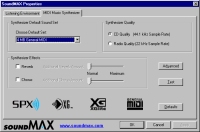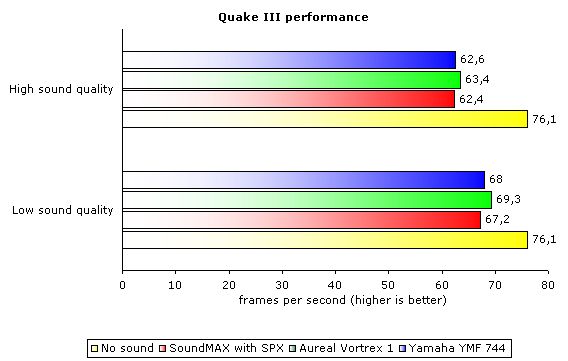|

|
While it's pretty easy to purchase a cheap PCI sound card these days (boards like the Sound Blaster PCI128, Aureal Vortex series, Yamaha YMF based cards, etc), do keep in mind that the problems with such hardware is that they offer a limited feature set, mediocre 3D audio acceleration and generally don't sound as good as more expensive sound cards on the market.
65% Rating: 
|
|
|
|
Home >
Reviews >
Audio / Sound >
Analog Devices SoundMAX-SPX |
|
|
Driver screenshots
By taking a look at the following driver screenshots, it's quite
clear that SoundMAX 3.0 has many options to customize. These screenshots were
taken from the Win98SE driver set so driver look might be a bit different under
Windows 2000 or Windows ME but the feature options are the same.
It is
possible to implement preset or user defined 3D environmental effects to any
output source (Wav, MIDI etc) and adjust the power of the effect. This feature
is found only in expensive sound cards such as the Sound Blaster Live!
series.
 |

|
|
|
|
(Click image to
enlarge) |
(Click image to
enlarge) |
|
Sound
quality
While most AC97 solutions offer mediocre sound reproduction, the
output of the D815EPFC based on SoundMAX with SPX was quite satisfying.
Frequency response seemed to be on the right track. Bass reproduction sounded
deep and medium frequencies sounded rich. Higher frequencies were well adjusted
as well.
However, there we did come across some limited background
interference (noise) at very high volumes. Interestingly, the maximum output of
the SoundMAX 3.0 is much higher than what most PCI sound cards can offer. So, in
terms of signal to noise ratio, the SoundMAX 3.0 is much better off than other
AC97 CODEC's but less clear than most PCI sound cards.
I am absolutely
positive that SoundMAX 3.0 can efficiently drive any PC speaker set. While the
tested board came equipped with a single AD1885 CODEC (which means it supports
only 2 channels), it can be configured up to a 5.1 (6 channel) output through a
CNR audio riser (which will have 2 addition AD1885 codec). Output quality during
our tests might have been even better if the AD1885 was installed on a CNR board
due to less electromagnetic interference.
The driver set allows playback
of multiple .wav streams simultaneously: we managed to play many .wav/mp3
streams without a problem. Of course, this digital mixing is done through
software drivers and the host CPU.
Gaming performance

The above Quake III scores were taken at a low
resolution of 640x480. Scores at these settings are affected mainly by
CPU/system performance. The additional load created by SoundMAX 3.0 drivers on
the low end test bed processor (566 MHz) is almost non existent compared to the
other PCI sound cards. If users prefer playing games at very high resolutions
with a high end video adapter and a high end processor, the main bottleneck will
be the fill rate of the video card or its memory bandwidth. Even though this
chart represents one of the worst case scenarios for SoundMAX with SPX
technologies, SoundMAX drivers performed admirably. It's quite clear that the
drivers are very well optimized, creating minimal CPU overhead.
|
|
|
|
